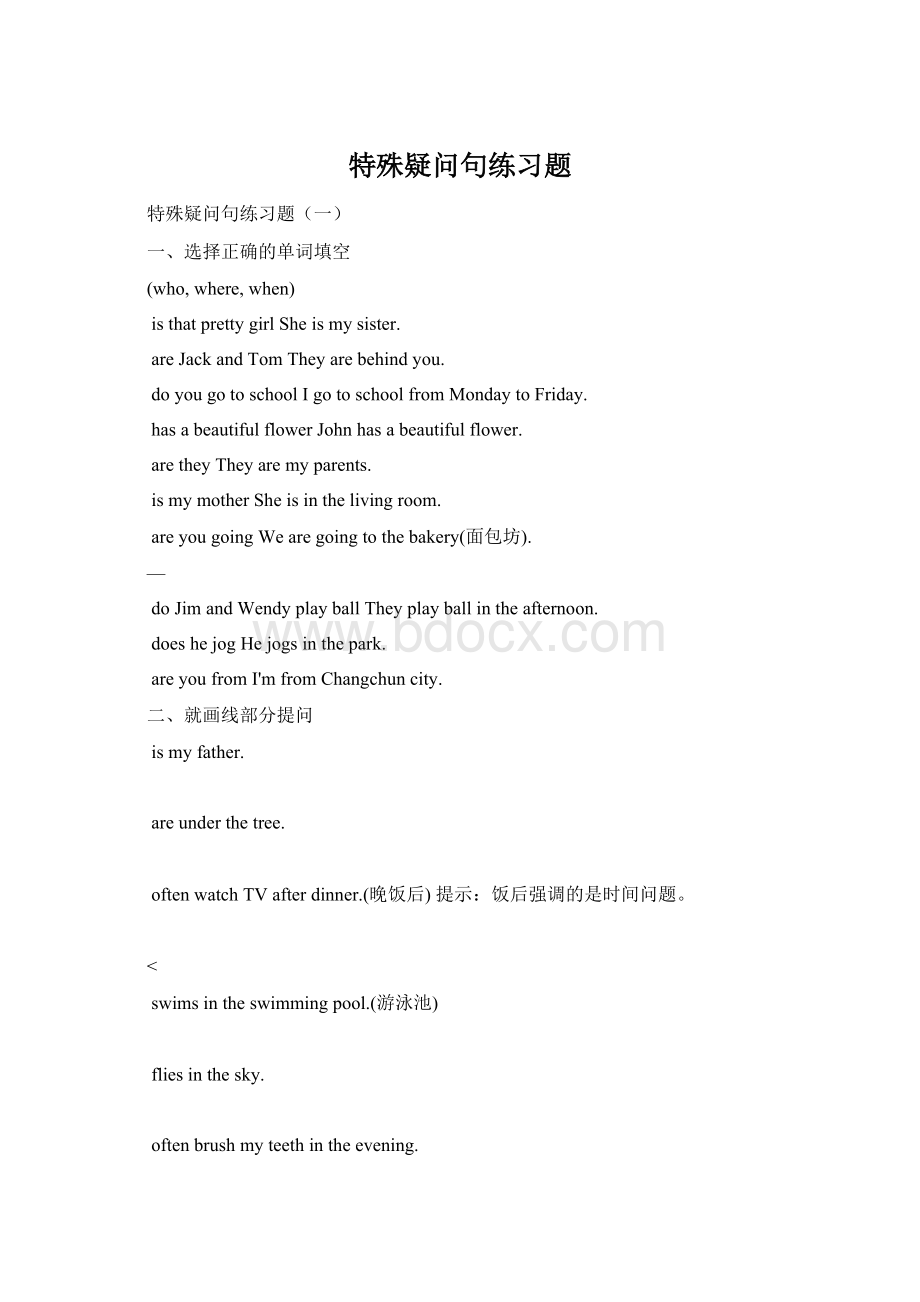特殊疑问句练习题.docx
《特殊疑问句练习题.docx》由会员分享,可在线阅读,更多相关《特殊疑问句练习题.docx(18页珍藏版)》请在冰豆网上搜索。

特殊疑问句练习题
特殊疑问句练习题
(一)
一、选择正确的单词填空
(who,where,when)
isthatprettygirlSheismysister.
areJackandTomTheyarebehindyou.
doyougotoschoolIgotoschoolfromMondaytoFriday.
hasabeautifulflowerJohnhasabeautifulflower.
aretheyTheyaremyparents.
ismymotherSheisinthelivingroom.
areyougoingWearegoingtothebakery(面包坊).
—
doJimandWendyplayballTheyplayballintheafternoon.
doeshejogHejogsinthepark.
areyoufromI'mfromChangchuncity.
二、就画线部分提问
ismyfather.
areunderthetree.
oftenwatchTVafterdinner.(晚饭后)提示:
饭后强调的是时间问题。
<
swimsintheswimmingpool.(游泳池)
fliesinthesky.
oftenbrushmyteethintheevening.
likestoplaywithBill.
'sfatherplaysbadminton(羽毛球)everyweekend.
<
supermarketisneartheschool.
laptop(笔记本电脑)isonthetable.
hasapairofearrings(耳环).
flowersareintheflowerpot(花盆).
grandpatookustothezoo.
?
putthegoldfish(金鱼)intothefishtank(鱼缸).
monkeysleepsatnight.
特殊疑问句练习
(二)
一.用whattime,whatcolor,whatday,what填空。
1.A:
_____________isit B:
Itisnineo’clock.
2.A:
_____________doesyourmothergetup
B:
Mymothergetsupat6:
30.
【
3.A:
_____________doyougotobedB:
Igotobedat10:
00.
4.A:
_____________doDianaandFionahavesupper
B:
DianaandFionahavesupperat18:
00.
5.A:
_____________isitB:
Itispurple.
6.A:
_____________istheskyB:
Theskyisblue.
7.A:
_____________isyourcoatB:
Mycoatisblack.
8.A:
_____________isthedogB:
Thedogiswhite.
9.A:
_____________istodayB:
TodayisMonday.
10.A:
_____________istomorrowB:
TomorrowisTuesday.
11.A:
_____________wasyesterday(昨天)B:
YesterdaywasSunday.
:
12.A:
_____________doyoulikeB:
Ilikered.
13.A:
______isthisThisisacomputer(电脑).
14.A:
______areyoudoingB:
Weareplayingbasketball.
15.A:
______doesyourmotherdoB:
Mymotherisapolicewoman.
16.A:
______arethoseB:
Thosearepeppers(辣椒).
17.A:
______isintheboxB:
Alovelydollisinthebox.
18.A:
______isonthetableB:
Theappleisonthetable.
19.A:
______isintheclassroomTheblackboardisintheclassroom.
20.A:
__________________B:
Maryishungry.
21.A:
______________________________
—
B:
Myfavoritecolorispink.
22.A:
________________________B:
Nickisplayingtabletennis.
二.连线:
(Match)
1.What’sonthechair Thereisabookinthebag.
2.Howisyourfather Theseareapples.
3.Whatarethese Igotoschoolbybus.
4.Whatisinthebag Theradioisonthechair.
5.Howdoyougotoschool Myfatherisfine.
6.Howmuchisit Iwashmyfaceinthemorning.
~
7.Whattimeisit Ihavetwohands.
8.Whendoyouwashyourface Itisfouro’clock.
9.Howmanyhandsdoyouhave Itis5RMB(人民币).
doyouhavelunch Ihavelunchatnoon.
:
一、词类:
动词、名词和形容词不太容易区分,如不能一眼看出,可用如下方法:
先用“一(量词)”(如:
一个、一张等)和这个词连起来说,如说得通,一般认为是名词;说不通再用“很”去判断,就是把“很”和为个词连起来说,说得通一般就是形容词;都说不通就是动词。
(目前我们学过的,以后可能不同)(另外一些很明显的,如人称代词、数词、情态动词等一下就可以知道)
1、动词
这里所说的动词是指各种动词总称,其中包括行为动词(就是我们平时总说的那种动词)、be动词、情态动词。
(1)行为动词
就是我们平时上课时说的动词,表示某一动作或行为。
如:
sweep、live等。
【
行为动词我们已学过它们的四种形式:
原形、+s/es、+ed、+ing,具体判断方法如下:
↗有,就加ing
读句子→读该单词→认识该单词→理解意思→看有无be动词(若是begoingto就用原形)
↘没有,再看情态动词
↗有,就用原形
↗有,就加ed
↘没有,再看有无表示过去的时间状语↗是第三人称单数就加s或es
↘没有,再看主语
↘不是第三人称单数就用原形
-
(2)be动词
a、Am--wasIs--wasAre--were口诀:
我用am,你用are,is用在他她它,所有复数全用are。
b、肯定和否定句Iam(not)fromLondon.Heis(not)ateacher.Sheis(not)inthediningroom.Myhairis(not)long.Hereyesare(not)small.
c、一般疑问句AmIaChineseYes,youare.No,youaren’t.AretheyAmericanYes,theyare.No,theyaren’t.IsthecatfatYes,itis.No,itisn’t.
我们现在学过的be动词大致分两类:
is、am、are为一类,一般用于一般现在时、现在进行时和一般将来时中,was和were为另一类,一般用于一般过去时。
判断步骤:
↗第一、三人称单数,就用was
↗有,再看人称
↘第二人称单数和所有复数,就用were
看有无表示过去的时间状语
↗第一人称单数,就用am
;
↘没有,再看人称→第三人称单数,就有is
↘第二人称单数和所有复数,就用are
(3)情态动词
情态动词也是一类特殊的动词,平时我们不把它说成是动词。
情态动词可以和行为动词同时出现在同一个句子中。
我们现在学过的情态动词有:
can、must、should、would、may。
接触最多的是can。
情态动词后动词总是用原形。
(不受其他任何条件影响)
2、名词
表示某一事物,有具体的和抽象的之分。
判断的关键词往往是be动词,be动词如果是am、is或was,名词就用原形;be动词如果是are或were,名词就加s或es。
这里强调两点:
不可数名词都默认为单数,所以总是用is或者was;最好不要根据some、any、alotof等词去作判断,以免受误导。
如何加后缀:
¥
a.一般情况下,直接加-s,如:
book-books,bag-bags,cat-cats,bed-beds
b.以s.x.sh.ch结尾,加-es,如:
bus-buses,box-boxes,brush-brushes,watch-watches
c.以“辅音字母+y”结尾,变y为i,再加-es,如:
family-families,strawberry-strawberries
d.以“f或fe”结尾,变f或fe为v,再加-es,如:
knife-knives
e.不规则名词复数:
man-men,woman-women,policeman-policemen,policewoman-policewomen,mouse-micechild-childrenfoot-feet,.tooth-teethfish-fish,people-people,Chinese-Chinese,Japanese-Japanese
判断步骤:
↗如是am、is或was→原形
读句子→读该单词→认识该单词→理解意思→看be动词
↘如是are或were→加s或es
3、形容词(包括副词)
形容词表示某一事物或的特征,副词表示某一动作的特征。
^